The Amalfi Coast is one of the most beautiful destinations in southern Italy, known for picturesque sights, memorable architecture, and breathtaking views of the crystal-clear waters of the Tyrrhenian Sea.
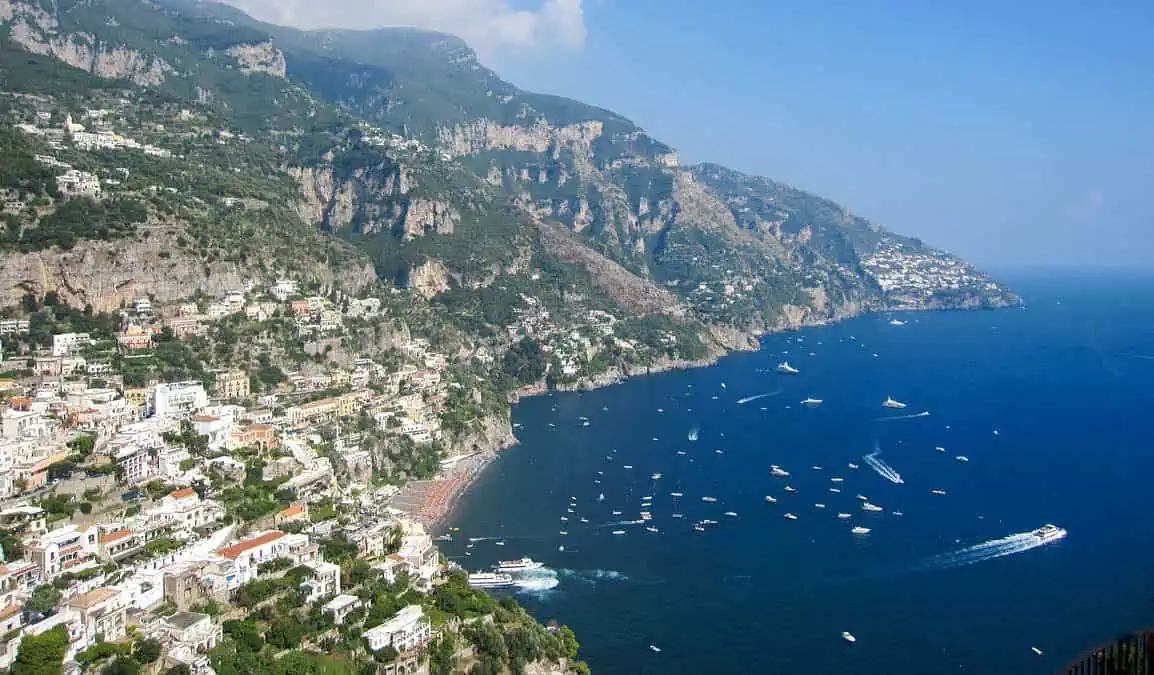
Meanwhile, Rome is the capital of Italy, one of the most famous cities in a country full of tourist attractions. It makes sense that some people looking to travel to Amalfi Coast will start at Rome. However, due to the location of the coast, direct travel may be difficult. Travelers looking to experience the pastel shades and glorious beaches of the coast will need to plan ahead.
But don’t worry! We’re here to help you out on how to get around Italy, this article will cover how to get from Rome to Amalfi Coast.
Route One: Rome to Amalfi Coast via public land transport
Italy has a great public transport system, which tourists use to their advantage in traveling around this fine country. You can take a bus, direct, intercity, or regional train from almost any major city to get to another. However, getting to Amalfi Coast from Rome will involve a fair bit of moving around, as you’ll need to transfer from bus to train.
Rome to Naples by train
Let’s say you get off at the airport in Ciampino or the more popular Leonardo da Vinci–Fiumicino Airport. Your ideal starting location in Rome is the Roma Termini Train Station, Italy’s largest train station and a notable stop for numerous direct and regional lines, where you can take high-speed trains to Napoli Centrale station in Naples. Two main train companies offer this type of transport: Trenitalia and Italo Trains.
They are very close in terms of price for train tickets and comfort, so you can pick one that suits your schedule best. But if you want to experience the fastest high-speed train in the country, you can book a seat on Trenitalia’s Frecciarossa trains.
How much does it cost, and how long would it take to get from Rome to Naples by direct train?
Travel time between these two cities ranges from 55 minutes to an hour and thirty-six minutes. Prices for train tickets range from €14 to €71 for both regular direct and high-speed train rides. Trains usually run throughout the day and early into the night, so consider that when planning your travel. As usual, we recommend that you purchase your train tickets in advance.
Naples to Sorrento by train
Once you arrive at Napoli Centrale, walk to the nearby Naples Garibaldi Station. Descend to the lower levels and ask for the Circumvesuviana line or Porta Nolana to Sorrento, which is your next destination. Circumvesuviana has regional trains with multiple stops, and their schedules go between 5:57 am and 9:33 pm. Ticket prices range from €5 to €8. Travel time from Naples to Sorrento takes about one hour. You can also take the Campania Express trains, which have air conditioning and are more spacious and comfortable, but tickets can cost up to €15.
Sorrento to Positano or Amalfi by bus
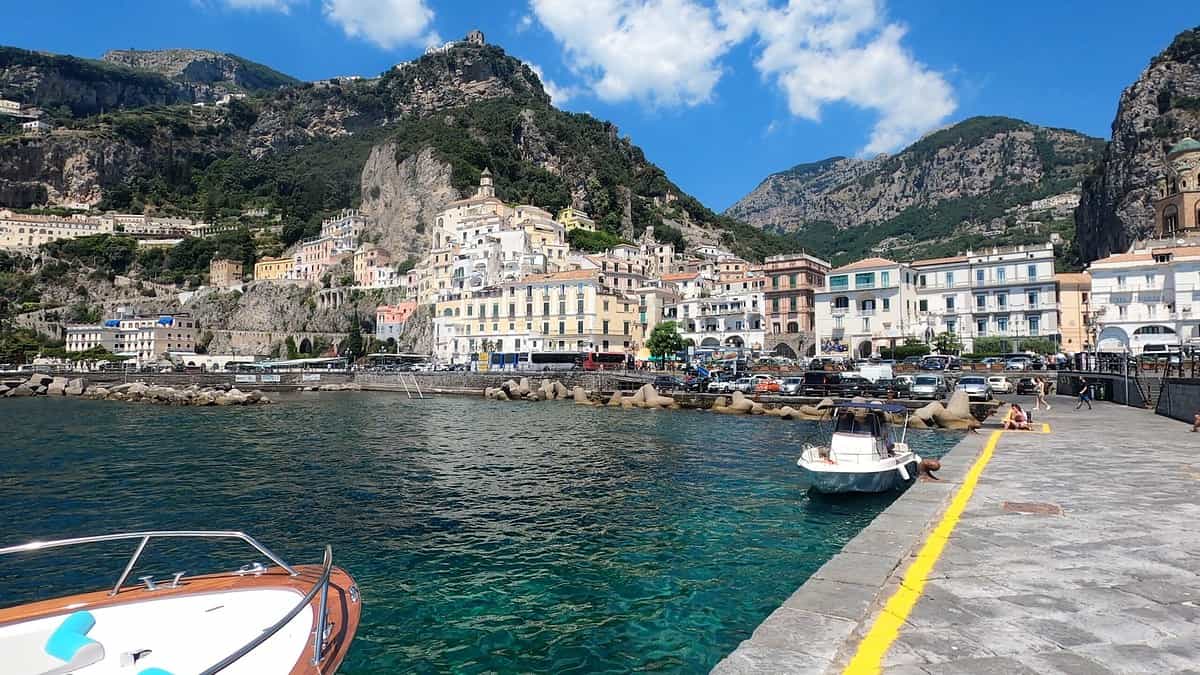
Once at Sorrento, you can have your pick of preferred travel arrangements. The first and most economical step is taking a SITA bus to Positano, arguably one of the most beautiful communes along the Amalfi Coast. Positano is high up on the coast, and you can stand on the cliffs overlooking the Mediterranean Sea. You can purchase tickets at a ticket booth in the Circumvesuviana station and find the stop for the SITA bus nearby at Piazza Giovanni Battista De Curtis. Just look for the bus stop signs. Also — and this is crucial — you must purchase bus tickets from the ticket booth at the train station. Tickets cannot be purchased online or on the bus itself.
The buses often leave town full, sometimes with passengers standing along the aisles. We recommend getting seats on the right-hand side of the bus if you can manage it to enjoy the view on the way. Travel time from Sorrento to Positano takes about an hour. You can also purchase tickets that will take you directly to the town of Amalfi, and the travel time will take about 90 minutes.
Naples to Amalfi by direct bus
There is also an option to take a bus straight from Naples to Amalfi, but the route doesn’t go through the Amalfi Coast itself. Instead, you’ll have to go around the mountains and through the very end of the coast, limiting your sights and potential stopovers. You can find more information about this trip here.
How to know if this option is for you
Taking trains and public buses from Rome to Amalfi Coast is by far one of the cheapest ways to travel. Of course, the savings come with the trade-off of being less comfortable and possibly more inconvenient. There are a lot of trains leaving from Roma Termini and Napoli Centrale, but they do run on tight schedules. Some train companies also offer different levels of service. For example, Campania Express trains from Naples to Sorrento are more suited for families with children, as they tend to be more comfortable. They offer guaranteed seating, air-conditioned cars, and baggage spaces. For that reason, they’re more expensive than other regional trains. They also have fewer stops along the way.
There is also the issue of crowds. Roma Termini and Napoli Centrale are tourist attractions in their own right, so expect a lot of people there, especially during rush hour and peak seasons. As mentioned before, SITA buses from Sorrento to the Amalfi Coast also tend to be overcrowded, especially during the mornings and summer months.
Route Two: Rome to Amalfi Coast by car
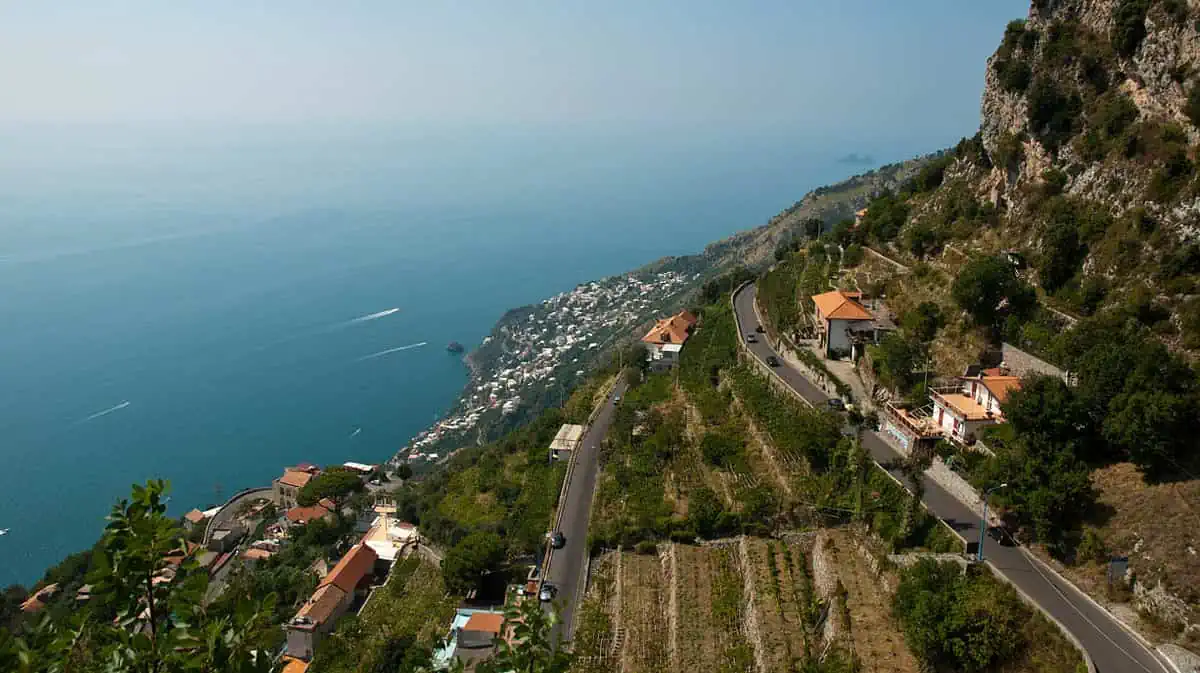
Not everyone likes public transportation, and going to Amalfi Coast by car is a great choice for people with more resources. You can schedule the trip whenever you want and take the time to stop and see the sights along the way. It also offers more flexibility, but, as said, it comes with a price.
Rome to Naples by train (again)
Having a lot of money to burn on your trip to the Amalfi Coast doesn’t mean that you shouldn’t consider saving a few euros on easy choices. Case in point: taking a direct train ride (again) from Romana Termini train station to Napoli Centrale will help you cut down on effort, time, and costs.
Once you’re in Naples, you can then explore your options for getting to the Amalfi Coast by car. You can either get a rental car, hire a taxi, or hire a private driver. Price points differ among these choices, with hiring a private driver being the most expensive. You’ll also need an international driver’s license in order to drive here. You can check out our article about driving in Italy for more information.
Directions to Amalfi Coast
You can take the A3 Autostrada and follow the signs leading to Salerno/Reggio Calabria. Stay on the highway until you reach the town of Vietri sul Mare. This town is a tourist attraction in its own right, but it’s mostly known as the entrance to the Amalfi Coast and a strategic transportation hub. Once in town, exit the highway and make your way to the SS163, also known as the Amalfi Coastal Road or the Amalfi Drive. It’s about 50 km along winding roads offering picturesque sea views. You can take the time to explore the smaller charming communes along the way, like Cetara, Maiori, Minori, and Atrani. Then you can stop at Positano or Amalfi town itself, depending on your preference.
Advantages of going to the Amalfi Coast by car
Let’s take a look at what advantages driving a rental or hiring a driver can offer you.
Get there on your own time
Depending on your options, you can go on a day trip or drive around at night, which is something that public transportation cannot match with any degree of flexibility.
The choice to stop for scenic views
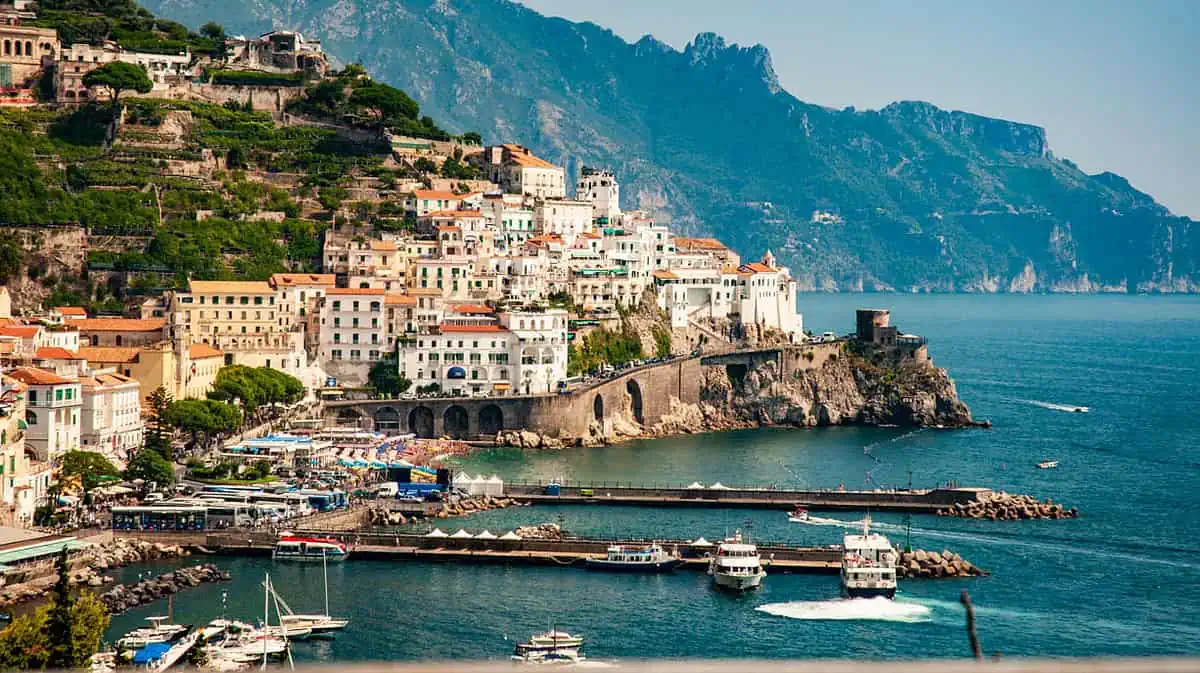
You can’t just tell bus drivers to stop so you can take a picture of the beautiful sunrise on the azure horizon. Going to the Amalfi Coast in your own car allows you to make stops whenever convenient or needed, giving you time to stretch your legs, take in the sights of the coast, and rest for a quick coffee or snack.
Exploring places off the beaten track
In connection to the previous topic, driving to the Amalfi Coast allows you to take the roads less traveled and explore places like the Bay of Ieranto or the Furore Fjord. There are quite a few hidden gems in this part of southern Italy, all waiting to be explored.
Disadvantages of driving to the coast
The Amalfi Drive giveth, and the Amalfi Drive taketh away. Here are the most notable disadvantages of driving to the coast.
Road congestion
Since you’ll be starting in Naples, you’ll experience first-hand just how much traffic an Italian city street can have. This isn’t just limited to Naples, though; coastal towns like Positano have narrow streets, busy areas, and tons of pedestrian traffic. You or your hired driver will have to navigate your what through all that on your way to the Amalfi Coast.
The twisting and narrow SS163
The Strada Statale 163 Amalfitana is carved along the sheer cliff face of the Amalfi Coast facing the Tyrrhenian Sea. It offers a great view but hugs the cliffs too closely in some places, resulting in narrow sections, steep inclines, blind curves, and sharp turns. Inexperienced and first-time drivers are in for a hell of a time on the SS163, so don’t even try it if you fall under those categories — especially at night.
Unpredictable road conditions
Like any passage near a cliff or mountain, rock slides can sometimes cause blockages on Amalfi Drive. These can result in time-consuming diversions up or around the mountain roads. There are also a few places with potholes and uneven surfaces, making navigating without prior experience very challenging.
Restrictive availability and cost of parking
You certainly wouldn’t be the only one driving from Rome and Naples to the Amalfi Coast, I can tell you that much. Since the place is a tourist hotspot, you can expect difficulty getting parking spaces in Sorrento, Positano, Amalfi, and all the other smaller towns, since most of them are designed for foot traffic. Parking several blocks away from your intended destination is not unheard of, and so is paying extravagant parking fees.
Route Three: Rome to Amalfi Coast via train and ferry
Direct trains, regional trains, buses, rental cars, or a car of your own — there are many ways to get from Rome to the Amalfi coast using land-based transportation options. But if you want to enjoy the full view of the Tyrrhenian Sea while on your way to Amalfi Coast, getting a ferry ride is one of the best ways to do so.
Rome to Naples by train (yet again)
Well, here we are again, talking about trains and train stations. Roma Termini, Napoli Centrale, you know the drill. It’s the same process as the last two routes and a great testament to how well-connected popular places in Italy are by intercity trains.
Direct ferry from Naples to Amalfi Coast
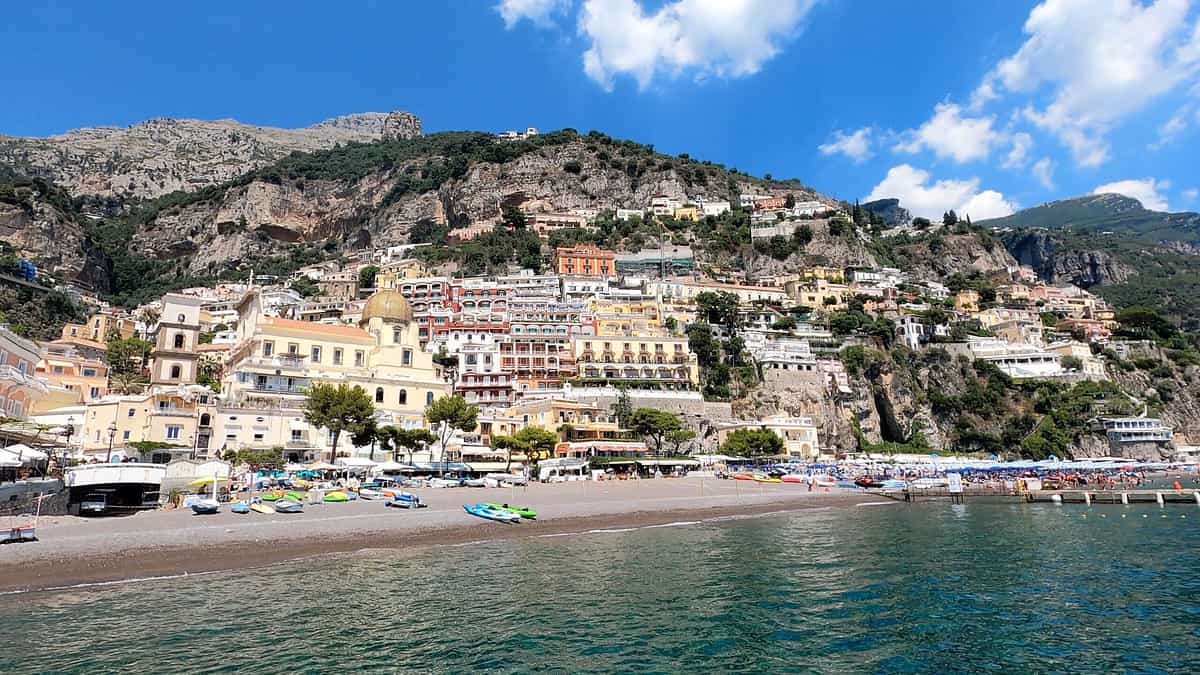
Straight ferry crossings from the Naples harbor to Amalfi Coast are available during peak seasons, from April to the end of October. These seasonal routes are operated by Navigazione Libera del Golfo (NLG) and Alilauro. You can find both ferry and cruise ships in Molo Beverello, Naples’ main port.
The ride usually takes one and a half to two hours, depending on weather conditions and specific routes, and the price range is between €25 to €28.50. This is a practical option for your Rome to Amalfi Coast excursion, but they are not always available.
Naples to Sorrento, then to Amalfi Coast
A more season-friendly option is taking a train from Napoli Centrale to Sorrento, then getting on a ferry in Marina Piccola, Sorrento’s main port and one of the most important maritime drop-offs in the region of Campania.
What are the companies that offer ferry rides to Amalfi Coast?
The most popular ferry operators for Sorrento to Amalfi Coast trips are Seremar, NLG, Alilauro Gruson (and Alicost.)
How much does a ferry ride from Sorrento to Amalfi Coast cost?
Depending on your chosen operator, ferry tickets can range from €17.50 to €19.
How long does a ferry ride take?
Sorrento to Amalfi takes about a little over an hour on average. It can go faster or slower depending on your operator of choice and weather conditions.
Route Four: Experience the Amalfi Coast from Rome via a tour

Signing up for a tour of the coast is by far the easiest and most stress-free option available to tourists. All your travel arrangements are made for you (whether it’s land- or sea-based, or both), everything is scheduled, most of them include meals and snacks, and all you need to worry about is showing up on time. Most tours have their own buses and transportation set up to pick you up directly from your hotel room door. We highly suggest you consider this option if it’s within your means.
Frequently asked questions
Here are a few more nuggets of information that can help make your trip from Rome to Amalfi a little bit easier.
Traveling from Rome to Amalfi may be difficult on your first few visits, but once you get used to the process and have familiarized yourself with the transportation options, you can make the trip without too much issue.
Unfortunately, there are no direct trains or buses from Rome to Amalfi. It may sound like a hassle, but you can circumvent most of the inconvenience if you check your schedules and plan accordingly or follow the travel routes above. There are also a lot of popular destinations along the way, giving you opportunities to stop and rest or maybe stay for a night or two. There are about 173 miles (278km) between Rome and Amalfi Coast; as you can expect, it may take a few hours to get there.
Here are a few general guidelines for traveling to Amalfi Coast. All these things apply whether you’re taking the local train, ferry, or SITA bus.
Book your tickets in advance. Always, always check if it’s possible to buy tickets before arrival. This goes for any mode of public transport in Italy and perhaps all over the world. It just makes perfect sense, and it takes out a lot of hassle in your travels. If not possible, remember that not all transportation options allow the purchase of tickets during the ride.
Check your schedules. Though not usual, train, bus, and ferry schedules are subject to change depending on factors like passenger count and weather conditions. Confirm your schedules online or call your transport provider’s customer service number for more details.
Arrive early. Be there at least an hour before the ferry, train, or bus starts to take in passengers. You’ll need time to look for the right gates, go through security checks, and have a few minutes to settle.
Pack light, but pack wisely. Don’t overburden yourself with too much luggage for a short trip, but do remember to bring protection like sunglasses, sunscreen, or jackets as required. You might also consider taking emergency medication for motion sickness and other travel-related issues.
Closing thoughts
We hope this article has convinced you to visit the Amalfi Coast from Rome. It is a beautiful place — despite the slightly complicated travel requirements, you might enjoy the breathtaking and magnificent sights of the coast. And once you’re there, you might think that it is all worth it.
